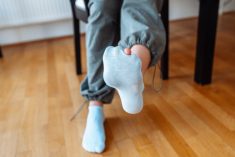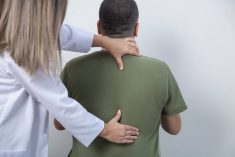It is a common belief that anxiety is a mental health condition. While anxiety certainly does have plenty of mental health implications, current research shows how the symptoms of anxiety can be managed through body focused tools.
If not managed effectively, anxiety symptoms such as a racing heart, nausea, shortness of breath, nervousness, difficulty sleeping or trouble connecting with others can become intrusive and have a significant effect on everyday lives.
Anxiety is more than a pathology, however. To better understand how our bodies are involved in the anxiety response, we need to widen our perspective on why anxiety happens in the first place.
Read Also

Gentle treatments for pain in the neck
Heading toward year-end, people unknowingly tense up against the cold and busyness, causing neck pain that can often be treated with appropriate support and gentle mobility, athletic therapist Kathlyn Hossack says.
Looking at it from a neuroscience perspective, anxiety will occur when feelings associated with our body and mind become alert to a potential threat or stressful stimulus. Anxiety is biologically designed to get us ready to react accordingly. Intrusive anxiety occurs when that reaction, or preparation to react, is contextually inappropriate to the moment.
Often, we interpret anxiety as a set state, even though it is designed to be a transient, temporary preparation. We feel as though anxiety is going to stick around, which “freezes” us into those symptoms.
Anxiety loves and craves action. This is where using our body can be of big value in managing intrusive symptoms.
A few simple, easy starting points for moving through intrusive anxiety include full body, dynamic movements. This might be putting on a song and moving to the beat for the duration of that song. Hopping, running on the spot or shaking the arms out can all be included in this process, or be done without music.
Something as simple as shrugging the shoulders and letting them drop on the exhales can also support a softening of intrusive anxiety symptoms. Doing a longer, open mouth exhale (like a sigh) over 10 to 20 rounds can be helpful as well.
Sometimes, amid acute anxiety, breathing feels harder than normal. When this happens, it can be beneficial to move your body in one of the suggested ways or others that are familiar.
You can also integrate helpful breathing techniques such as paced inhales and exhales (try in for four, and then out for four) or breathing in through the nose and then out with longer, sigh-like exhales through the mouth for a minimum of 10 rounds.
Because of anxiety’s nature to create and move energy in a preparative way, getting the physicality of our body involved will help to regulate our nervous system and allow for other management techniques like breathing practices to assist.
Anxiety symptoms can also occur because our physical body is asking for our attention. This might mean something as simple as feeling thirsty or hungry, or some sign that your immune system is fighting something. Anxiety often does accompany or can be a symptom of physical pain.
Taking a moment to tune in to your body and acknowledging it may be trying to tell you something is sometimes enough to quell the anxiety symptoms. Anxiety, like pain, is not something we can power through and ignore. It is one of the body’s many signals to pay attention and act accordingly.
If you are experiencing intrusive anxiety, especially if it lasts and doesn’t seem contextually or logically appropriate, it is important to seek support. Having an external facilitator assist you in navigating what your body is saying and help you implement some meaningful tools can go a long way toward mitigating intrusive symptoms or long-term chronic issues associated with anxiety.
Excellent resources would be mental health providers, movement guidance like yoga, personal training or somatic-based professionals, or even a close friend who is able to be with you as a starting point. It is scary to experience anxiety and it’s important to remember none of us must face everything alone, nor do we need to.















